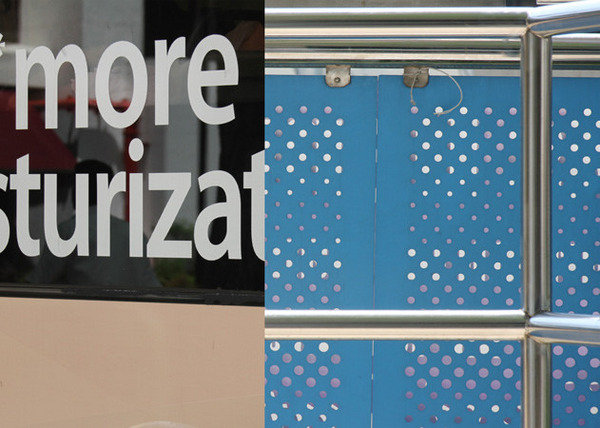Beat Streuli / Verne Dawson
dal 15/11/2011 al 22/11/2011
Segnalato da
15/11/2011
Beat Streuli / Verne Dawson
Galerie Eva Presenhuber (maag area), Zurich
Streuli creates an open dialog between two very different types of motif. These pictures have a strongly cinematographic, narrative character, referring more clearly to the above- mentioned before and after. Dawson's painting focuses with positively anthropological zeal on the history of humankind's evolution and impact in dialog with the world around it

Beat Streuli
Transit
On November 16, Galerie Eva Presenhuber will be opening an exhibition of new works by Beat Streuli.
Since the late 1980s, Streuli has been tirelessly expanding his visual atlas of the world’s major cities, moving through the streets of New York, Brussels, Buenos Aires, Cape Town, St. Petersburg and many others. In the resulting pictures, these specific places can no longer be identified with any certainty. Instead, Streuli reduces his view of these cities by concentrating on their inhabitants, drawing a picture of people in the urban civilization that surrounds them.
By using a zoom lens to isolate individuals within the crowd, the artist confronts the viewer, who could also be under such observation, with a situation that is at once highly artificial and entirely natural. The spaces that become stage-like backdrops in Streuli’s photographs are the same spaces we move through every day, and we suddenly become aware of ourselves: “... so this is what it looks like when I walk through the streets.” Within the exhibition and the image this becomes a dramatized moment, while in reality, with a before and after, with the usual background noise, it becomes part of our everyday life.
In this exhibition, entitled “Transit”, Streuli creates an open dialog between two very different types of motif. On the one hand, there are figurative images which, following a recent trend in Streuli’s work, capture small dramatic moments: someone cautiously throws a longing look at a woman, money changes hands, a cat is held protectively in the arms of its owner. These pictures have a strongly cinematographic, narrative character, referring more clearly to the above- mentioned before and after.
And then there is a group of pictures that are positively abstract. Monochrome surfaces overlap, sometimes slightly shadowed, in some places coming up against mirrored windows. Telling where and how these pictures were shot is often difficult, if it is possible at all. For although the base material here is all shot together at the same place, there is no longer a real point of reference: digitally processed, pictorial space becomes a field of formal experimentation.
Born in Switzerland in 1957, Streuli lives in Zurich and Brussels. His photographs, videos and window installations have been shown at museums and galleries worldwide, and permanent installations are to be found in the Lufthansa Aviation Center at Frankfurt Airport, the Technical University and the Triemli Spital in Zurich, the Style Company Building in Osaka, and the Immigration Hall at Fort Worth International Airport in Dallas.
---
Verne Dawson
With a solo exhibition of the american painter Verne Dawson, Galerie Eva Presenhuber is pleased to show new works.
Increasingly well-known since the mid-1980s, especially in New York, Dawson’s painting focuses with positively anthropological zeal on the history of humankind’s evolution and impact in dialog with the world around it. The universal manner in which the artist views and examines the world is evident in his complex cycles of works. Recurring themes including astrology, numerology, religion and mythology become the key sources from which his pictorial narratives are fed. In this way, Dawson’s works offer a door to a world which has always existed, and which still exists, but which has been marginalized by the many-layered interconnections of modern civilisation.
When Dawson gives one of his new works the Native American title Apalachicola, he immediately takes the viewer behind the harmless-looking surface of the picture. On a path that winds its way through primeval vegetation, a line of people move towards the beach of a nearby sandy bay. Between them, on their shoulders, they carry a smouldering fire, its column of smoke rising into a gloomy sky. Here, the landing of the Spanish explorer Hernando de Soto at Apalachicola Bay in the Gulf of Mexico becomes a threatening prophecy of imminent expulsion from a primal paradise. Another painting, Tallahassee, also has its roots in de Soto’s devastating and bloody voyage of discovery. After a night of drinking, a ghostly skeleton slings the naked body of a young woman, wine glass still in hand, over his shoulder. Once again, the title is a Native American reference, as the land on which the city of Tallahassee now stands once belonged to the hunting grounds of the Seminole Indians. Today, college students hold excessive weekend parties there.
At the same time, the sheer pleasure Dawson takes in painting can always be sensed in his work. As he says: “One year of Hans Haacke’s sculpture class, where students brought in fifteen conceptual art projects every week, convinced me that the preservation of the past, of painting, was the most interesting and challenging endeavour a conceptual artist could choose.” Portraits like Ugo and John, as well his self-portrait, are subtly observed, as are the avian couple who meet up in Two Birds On A Wire.
The Old Mill Calendar, a room-filling work conceived as a mural that was recently shown at the Yokohama Triennial, consists of four large-format canvases. Where the individual panels meet, colours and forms continue from one pictorial space into the next, presenting the viewer with a cycle that describes the path of life on earth from darkness to light, from low to high tide, from winter to summer, from happiness to misery, and from birth to death.
Image: (c) Beat Streuli
Opening november, 16th
Galerie Eva Presenhuber
Zahnradstrasse 21 - Zurich



